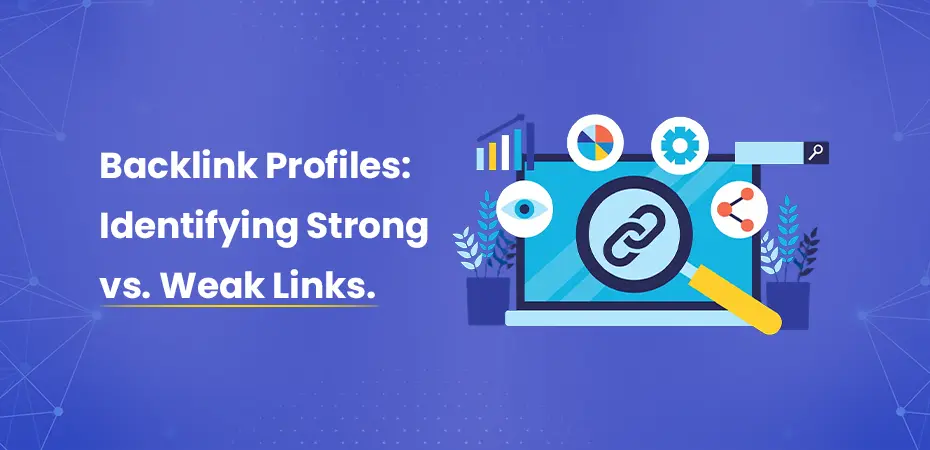Backlink Profiles: Identifying Strong vs. Weak Links



Have you ever wondered why some websites always rank higher in search results while others struggle to get noticed? The answer often lies in their backlink profiles – a crucial element that can make or break your SEO success.
A backlink profile is like your website’s digital reputation card. It’s a collection of all the links pointing to your site from other websites across the internet. These links act as votes of confidence in your content, telling search engines that other websites find your information valuable and trustworthy.
Think of backlinks as recommendations from trusted friends. When respected websites link to yours, search engines take notice. But not all backlinks are created equal – some can boost your rankings while others might harm your site’s reputation.
Understanding the difference between strong and weak backlink profiles is essential for any successful Search Engine Optimization (SEO) strategy. It’s the key to building a solid foundation for your website’s long-term success in search rankings and organic traffic growth.
This backlinking guide will help you identify strong and weak links for better SEO.
Defining a Backlink Profile
Backlinking means acquiring links from other websites to your own, helping improve SEO and site authority and a backlink profile is like a report card for your website’s online reputation. It shows all the links from other websites that lead to yours. These links are seen as endorsements from other sites, telling search engines that your content is valuable and trustworthy.
Key Components of a Backlink Profile
- Your back-link profile consists of several important elements:
- The total number of links pointing to your site
- The quality and authority of the websites linking to you
- The specific text used in these links (anchor text)
- How links are distributed across different pages on your website
- The relevance of the linking sites to your content
How Search Engines Evaluate Backlinks
Search engines have complex algorithms that assess these components. They consider factors such as:
- Domain Authority: Links from well-established, respected websites hold more significance than those from new or low-quality sites.
- Link Context: A link that is naturally embedded within relevant content carries more value than one placed randomly or in isolation.
- Link Patterns: Gradual and organic growth of links over time indicates genuine engagement, while sudden spikes may raise concerns.
The Impact of Backlinks on Your Website’s Authority
A healthy backlink (SEO) profile directly affects your website’s authority. When reputable sites link to your content, they pass on some of their trust and credibility to your domain. This transfer of authority, often referred to as “link juice,” helps search engines determine how well your site can rank for specific target keywords and topics.
Think of each high-quality backlink as a recommendation letter for your website. The more authentic endorsements you receive from respected sources, the stronger your online presence becomes.
Spotting a Strong vs Weak Link Profile: Key Characteristics to Look For
Let’s dive into the distinct features that separate powerful backlink profiles from weak ones. A strong link profile acts like a digital vote of confidence from reputable websites across the internet.
Characteristics of a Strong Link Profile
1. High-Quality Links
High-authority domains passing their “link juice” to your website create a substantial impact on your SEO performance. Think of links from educational institutions (.edu), government websites (.gov), or well-established industry leaders – these carry significant weight in search engine algorithms.
2. Link Diversity
A healthy mix of dofollow and nofollow links signals natural link building to search engines. Your profile (for linking) should include:
- Editorial links from blog posts
- Business directory listings
- Social media mentions
- Forum discussions
- Industry-specific platforms
3. Anchor Text Distribution
A natural-looking anchor text profile includes:
- Brand name mentions (40-50%)
- Generic terms like “click here” or “learn more” (20-30%)
- Relevant keywords (20-30%)
- Naked URLs (5-10%)
Red Flags in Weak Link Profiles
1. Toxic Backlinks
Watch out for these warning signs:
- Links from known spam domains
- Sites with suspicious TLDs (.xyz, .info)
- Pages filled with unrelated advertisements
- Websites with poor content quality
- Links from link farms or PBNs
2. Poor Link Diversity
A weak profile often shows:
- Links from a single type of source
- Identical anchor text across multiple links
- Links only from specific geographic regions
- Excessive exact-match keyword anchors
3. Irrelevant Connections
Search engines flag these patterns:
- Links from completely unrelated industries
- Backlinks from non-English sites to English content
- Sudden spikes in link acquisition
- Links from sites with no topical relevance
Your backlink profile tells a story about your website’s authority and trustworthiness. When examining your profile, consider each link’s source, context, and potential value to your overall SEO strategy. A strong profile grows naturally over time, while weak profiles often result from rushed, artificial link-building tactics.
Analyzing Backlink Profile Quality with Tools and Metrics
To effectively evaluate your backlink profile, you’ll need essential tools and metrics. Several powerful platforms can help you understand the quality and impact of your backlinks.
1. Google Search Console
Google Search Console provides free insights into your website’s backlinks. It shows you who’s linking to your site and which pages receive the most links. This tool is perfect for beginners starting their backlink analysis journey.
2. Ahrefs
Ahrefs takes backlink analysis to the next level with detailed metrics like:
- Domain Rating (DR)
- URL Rating (UR)
- Referring domains count
- Traffic value
3. SEMrush
SEMrush excels at competitive analysis, helping you discover your competitors’ backlink sources. The tool’s Backlink Analytics feature reveals toxic links and potential link-building opportunities.
4. Moz
Moz introduces two crucial metrics:
- Domain Authority (DA): Predicts how well a website might rank
- Page Authority (PA): Measures the ranking potential of specific web pages
These tools help measure “link juice” – the ranking power passed from one page to another through links. A high DA website (like .edu or .gov domains) typically passes more link juice than a low DA site.
Regularly using these tools for backlink audits will help you:
- Identify and remove toxic links
- Track new backlinks
- Monitor competitors’ link-building strategies
- Discover fresh link-building opportunities
The key to successful backlink profile analysis lies in combining data from multiple tools to get a comprehensive view of your link profile’s health.
Effective Link Building Strategies for a Strong Profile
Building a robust backlink profile requires strategic planning and consistent effort. Let’s explore three proven strategies that can help you secure high-quality backlinks.
1. Guest Posting
Creating valuable content for reputable websites in your industry opens doors to quality editorial links. The key lies in pitching unique, data-driven articles that provide genuine value to the host site’s audience. Remember to focus on websites with strong domain authority and relevant content alignment with your niche.
2. Digital PR Opportunities
Building relationships with industry influencers and participating in niche communities creates natural backlink opportunities. Consider these approaches:
- Responding to journalist queries through platforms like HARO
- Sharing expert insights on industry forums
- Creating newsworthy content that attracts media attention
- Participating in podcast interviews or webinar sessions
3. Broken Link Building
This strategy involves finding broken links on authoritative websites and offering your content as a replacement. Here’s how to implement it:
- Use tools like Check My Links to identify broken links
- Create high-quality content that matches the original link’s topic
- Reach out to website owners with a helpful, personalized message
- Suggest your content as a valuable replacement
Each strategy requires dedication and a focus on quality. The best results come from combining these approaches while maintaining authenticity in your outreach efforts. Remember to track your success rates and adjust your tactics based on what works best for your specific niche.
Monitoring and Maintaining Your Backlink Profile Healthily
Keeping your backlink profile healthy requires consistent attention and strategic management. Let’s explore essential practices to maintain a robust profile of backlinks.
1. Regular Health Checks
- Set up weekly automated reports through tools like Ahrefs or SEMrush
- Monitor new and lost backlinks to identify potential issues
- Track changes in referring domains’ authority scores
- Check for sudden spikes in backlink acquisition that might trigger red flags
2. Creating a Balanced Profile
A well-rounded backlink profile includes:
- Industry-specific news sites
- Educational institutions (.edu domains)
- Professional organizations
- Local business directories
- Social media platforms
- Forum discussions
- Industry-specific blogs
3. Smart Anchor Text Distribution
Natural anchor text distribution helps avoid over-optimization penalties:
- 40-50% branded anchors
- 20-30% generic phrases (“click here,” “learn more”)
- 20-25% naked URLs
- 5-10% exact match keywords
4. Red Flags to Watch
- Multiple links from the same C-class IP addresses
- Sudden increases in low-quality referring domains
- Unnatural anchor text patterns
- Links from sites in irrelevant languages or regions
Remember to document changes in your backlink profile and maintain a spreadsheet of your link-building efforts. This data helps identify patterns and adjust strategies for optimal results.
Conclusion
A healthy backlink profile is a crucial part of a successful SEO strategy. The quality of your inbound links directly affects your website’s authority and search engine rankings. Strong backlink profiles have a natural mix of high-authority domains, relevant content connections, and diverse link types. These elements work together to show trust and credibility to search engines.
Building and maintaining a strong backlink profile takes dedication, strategic planning, and continuous monitoring. The difference between strong and weak link profiles often comes down to the details – from anchor text distribution to the relevance of linking domains.
Need expert guidance to strengthen your backlink strategy? Our team at SEO Expert New York specializes in crafting customized link-building approaches that align with your business goals. We help businesses identify opportunities, eliminate toxic links, and build sustainable backlink profiles that drive long-term SEO success.
A strong backlink profile isn’t just about quantity – it’s about creating meaningful connections that enhance your website’s authority and value to your audience.